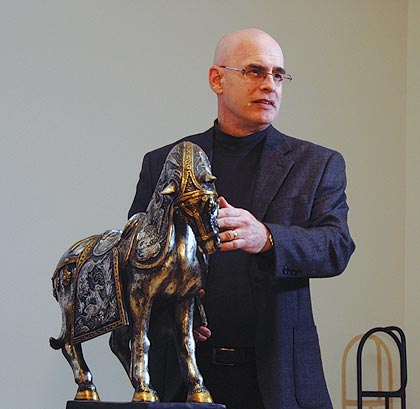
“Popular art is a celebration of the image. Great art is a celebration of the idea,” says Preston Metcalf, curator of Triton Museum of Art and current instructor of Mission College’s Survey of Asian Art course.
Indeed, a focus on the ideas behind Asian art is a vital component to the course’s curriculum. An art historian and professor, Metcalf doesn’t intend to dwell on names and dates of art pieces. His primary interest is to reveal why the works of art were created and to share the ideas and belief systems that generated a certain design.
Although Survey of Asian Art is an art history class, Metcalf will also guide learners to explore the ideas, philosophies, religions and historic events that inspired the art.
“A lot of art history professors are interested in how the art was made. To me, the interesting factor is why the art was made,” Metcalf says
“Why is a Chinese brush painting of a landscape so vast and mysterious as opposed to a European landscape, which is more detailed and realistic?” Metcalf says, giving an example to illustrate his style of lecture. “The answer lies in how each culture, east or west, viewed humanity and man’s place in the universe. It’s the differing ideas and philosophies that dictated how those landscapes were painted. The Chinese viewed humans as being simply one cog on the great wheel of the universe and that everything was cyclical. In their view, we are merely a part of nature. In the West, the Judeo-Christian traditions suggested at that time that humanity was dominant over nature and therefore played a more important role when set against nature or a landscape.”
Students enrolled in the course will study Asian paintings, sculptures, architecture, and decorative art, such as ceramics.
“We’ll also look at actual landscapes, like a Japanese zen rock garden and explore how that’s different than the cultivated gardens at Versailles,” Metcalf says.
Metcalf believes that a course exploring Asian art is important because it helps learners reflect on differences and similarities between cultures. He feels that once someone has an enhanced understanding of a culture, the culture becomes less intimidating.
“We are more alike than we are different,” Metcalf says. “Whether the artist was in China or India or South America or New York City or Santa Clara, they all have the same emotions, the same brain chemistries, the same dreams, the same fears, and the same hopes.”
According to Metcalf, his course explores art in the Far East from countries such as India, China, Japan, Korea, and Southeast Asia. He will cover the highlights of the art from Neolithic times to contemporary times.
There are a few openings left in Survey of Asian Art, section code 017744. Prospective students can attend the class held at Mission College on Mondays from 7-10:10 p.m. in MT-24 and request an add code from the instructor. Parking is $2 on campus.
